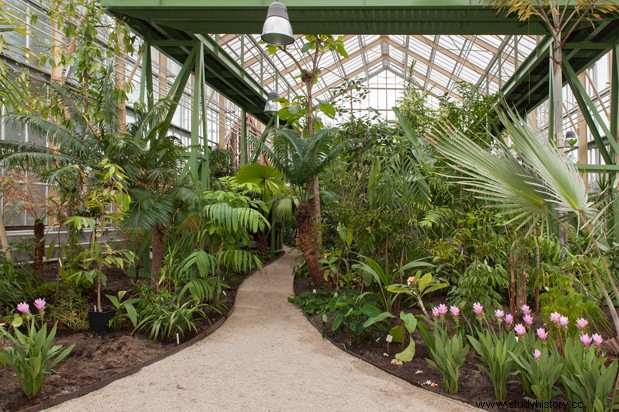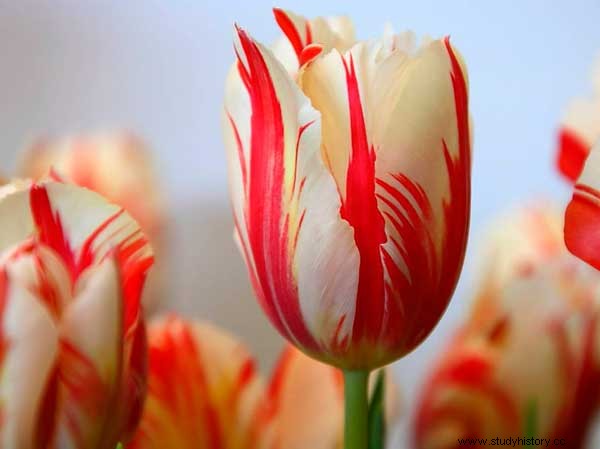In the 17th century, Holland experienced a speculative increase in prices in the market for the sale of tulip bulbs. This speculation, which caused some bulbs to be sold for thousands of guilders (up to forty times the average annual income of a person at the time), created the first economic bubble in history. A bubble that, when it burst (in a single day) in 1637, left thousands of Dutch bankrupt. The economic crisis generated by the fall in the prices of tulips, the panic and the ruin of many citizens finally led the Dutch economy to bankruptcy.
How tulips came to Holland
It's funny how tulips got to Holland, since the flower actually originates from Turkey and got there by rebound. It seems that everything is due to a certain Ogier Ghislain de Busbecq , who during the 16th century was the Austrian ambassador to Turkey (then held by the Ottoman Empire). Ogier was apparently very fond of floriculture, so on his return to Europe in 1544 he took with him some tulip bulbs to plant in the imperial gardens in Vienna. Years later, in 1573, the Holy Roman Emperor, Maximilian II of Habsburg , appointed Carolus Clusius court physician and head of the imperial garden (who was actually called Charles de L’Ecluse , but we already know how Latin was liked by the educated European elite of the time). The fact is that, thanks to his position, L'Ecluse was able to travel throughout Europe, collecting and collecting plant specimens. The stars of his collection were, due to their rarity (both were recent arrivals), the tulip and the potato.
The case of the stolen bulbs
In 1593 L'Ecluse accepted a position teaching botany at Leiden (in the Netherlands). I see it as a retirement. Imagine the man, almost seventy years old, and what travel was like in the 16th century. I guess when he was offered the job he didn't even think about it. So the good man went to Leiden thinking of spending her old years teaching botany while devoting her leisure hours to caring for his plant collection. Jealous of his greenhouse's crown jewels, he kept the tulips safe.

Hortus botanicus of Leiden, founded by Carolus Clusius
But someone broke into his garden one night and stole the bulbs. I guess he was someone more generous to his fellows than L'Ecluse himself, because soon tulips began to be seen all over Holland. As there is also the circumstance that sandy soils are apparently ideal for growing this plant, and Holland has plenty of that because most of it is land reclaimed from the sea, in the end the flower spread throughout the country.
The variations of tulips and their true origin
You probably already know that tulips are grown from bulbs, from which other bulbs come out that, when cut, give rise to a complete flower identical to the one produced by the original bulb. There are many common varieties of tulips, of different colors:yellow, red, purple, orange, pink, white... There are many, but in all of them the flower has a single color. However, sometimes something happens and a normal bulb gives rise to tulips with strange mixtures of colors. Unique varieties, impossible to repeat... unless they are obtained from the original bulb. Now we know that this is due to a virus inoculated by the plant aphid, but of course, in the middle of the 17th century the Dutch did not know anything about viruses (the first was not discovered until 1899). No, for them the origin of these rare and beautiful varieties was a complete mystery.
As the tulip only blooms for a few weeks in spring, during the rest of the year the bulb can be transported, sold, bought or exchanged very easily. And with all this in mind it is easier to understand what happened in Holland in the 1630s.
Tulipomania
When the Dutch began to take a liking to growing tulips, the most beautiful and rare varieties began to fetch well, and tulip bulbs began to generate a growing and increasingly uncontrolled market.

Semper augustus variety
Suddenly, overnight, varieties like the Semper augustus They began to sell for real fortunes. Houses, fields or farms were paid in exchange for a single bulb. And not only that, but bulbs that had not even been harvested yet began to be bought and sold, what in economics is known today as a futures market (a very advanced financial instrument that did not exist anywhere else in Europe). The Dutch however gave it a much more descriptive name:windhandel , “air business”.

Evolution of the price of tulips in the 1630s in the Netherlands
As if that were not enough, in 1636 there was a plague epidemic in Europe that seriously affected Holland, decimating the workforce. And of course, as there were fewer hands to grow and harvest bulbs, their price ended up skyrocketing… even more. There were no longer even enough properties to pay the "value" of the bulbs:assets were mortgaged, huge loans were requested, years of work were offered as payment... And often on a bulb that had not yet been harvested. Tulips made many speculators rich overnight.
The bubble burst
On February 5, 1637, in the city of Harlem , a batch of 99 tulips was sold for ninety thousand guilders (about fifteen thousand euros at current exchange rates), a much lower price than usual. In the tulip markets, voices began to be heard against the absurd level to which the situation had reached, and the next day a lot went on sale for 1,250 guilders without anyone bidding on them. Suddenly the price of tulips began to plummet:the bubble had burst .
Terror gripped all the investors who had tulip bulbs. Everyone wanted to sell them and recoup their investment before they found themselves bankrupt and still in debt for years on something that no longer had any value. There was no way, no one gave a florin for a tulip. Bankruptcies began to happen, first families and small businesses, then wealthy merchants and large trading companies. Laws were enacted that canceled future purchases in exchange for the payment of a small fine, and lawsuits for non-compliance followed one another. But nothing could be done now. Finally, within a few weeks of the market crash, widespread debt inability and widespread panic drove the Dutch economy into bankruptcy.
The tulip crisis:a lesson learned and forgotten over and over again
Dutch tulipomania It was, as I said above, the first speculative bubble in history. It presented a pattern that would later be repeated several times as the origin of various economic crises throughout history, some of them as recent as the “dot com crisis. ” in 2001 or newer subprime . And those of us who took out a mortgage in 2007 know that very well.
Does anyone really believe that we have learned our lesson and that there will not be another financial bubble? Unfortunately, history tells us no.
Collaboration of Enrique Ros of History Notes
